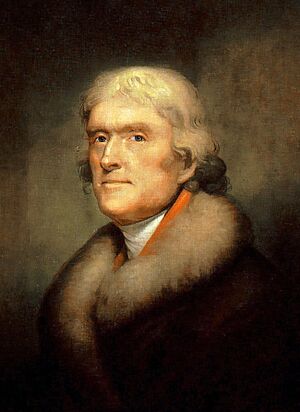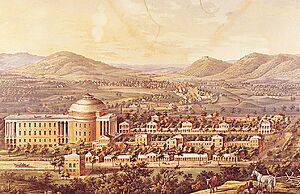History of the University of Virginia facts for kids
The history of the University of Virginia begins with Thomas Jefferson's idea for a new kind of college in the early 1800s. The university officially started in 1819, and its first classes began in 1825.
Contents
The University's Beginnings: 1800s
Jefferson's Big Idea for a New College

In 1800, when he was the Vice President of the United States, Thomas Jefferson wrote about his plans for a new college. He wanted to create a university in Virginia that was "broad and liberal and modern." He hoped it would be so good that young people from other states would want to come and learn there.
Later, as President of the United States, Jefferson explained that his new university would be "on the most extensive and liberal scale." He had studied at The College of William & Mary, but he felt it was too focused on religion and didn't teach enough science. So, he started planning a university that matched his own ideas about education.
How the University Was Founded
The University of Virginia was built on land that once belonged to James Monroe, who later became the fifth President of the United States. With Jefferson's guidance, the first building's cornerstone was laid in 1817. The state of Virginia officially approved the new college on January 25, 1819. Important people like James Madison, James Monroe, and John Hartwell Cocke worked with Jefferson to make his dream come true.
The university's first classes started on March 7, 1825. Unlike other colleges at the time, which often only offered studies in medicine, law, and religion, the University of Virginia allowed students to specialize in many different areas. These included astronomy, architecture, botany, philosophy, and political science. Jefferson famously said that the university would be a place where people were "not afraid to follow truth wherever it may lead."
One very new idea for the university was to keep higher education completely separate from religious teachings. The main building, the Rotunda, was designed as a library, not a church. This was very different from most other universities in the United States, which were often linked to a specific religion. Jefferson even said that teaching theology (religious studies) should not be part of the university. Because of this, the university has never had a divinity (religious training) school. However, today the university does have a strong religious studies department, and a non-religious chapel was built in 1890.
The Early Years and Challenges
Jefferson stayed very involved with the university, even hosting dinners for teachers and students at his home, Monticello, until he passed away. He was so proud of the university that he asked for his grave to mention only his role as the author of the Declaration of Independence, the Virginia Statute for Religious Freedom, and the father of the University of Virginia. He felt these were his greatest achievements.
After Jefferson's death, James Madison, the nation's fourth president, became the head of the university. The fifth president, James Monroe, also lived nearby and was part of the university's governing board.
In 1826, the famous poet Edgar Allan Poe studied at the university and was very good at Latin. The Raven Society, a group named after Poe's famous poem, still looks after the room where Poe lived during his time at the university.
The School of Engineering and Applied Science opened in 1836. It was the first engineering school in the United States to be part of a larger university.
In its early days, some students caused problems with their behavior. This upset Jefferson greatly. In 1840, a university leader, Professor John A. G. Davis, was killed during an incident involving student misbehavior.
A report from 2019 stated that slavery was "central to the project of designing, funding, building, and maintaining the school." The university has since built a Memorial to Enslaved Laborers to honor the enslaved people who worked there.
The Civil War Era
When the American Civil War began, the University of Virginia was the largest university in the Southern United States. It was second only to Harvard University in the entire country in terms of students and teachers.
The university was a place where many people supported the idea of slavery. About 90% of the students joined the Confederate army.
Unlike many other colleges in the South, the university stayed open during the war. In 1863 and 1864, there were only about 50 students, many of whom were injured Confederate soldiers. In March 1865, Union General George Armstrong Custer and his troops arrived in Charlottesville. They brought the Emancipation Proclamation, which freed all enslaved people. University leaders convinced Custer to protect the university. Although Union soldiers camped on the Lawn and caused some damage, they left peacefully, and the university was able to continue its classes.
The 20th Century at UVA

The University Gets Its First President
Thomas Jefferson had originally planned for the University of Virginia to not have a single president. Instead, a Rector and a Board of Visitors would share the leadership. However, as the 1800s ended, it became clear that this system was too difficult for managing the growing university and raising money.
In 1904, Edwin Alderman became the University of Virginia's first president. He started many changes for the university and for public education in Virginia. One important change at UVA was creating one of the first financial aid programs for students. This program, though simple compared to today's, offered loans to male students who needed help paying for school. Alderman served for 26 years, longer than any other president, until his death in 1931. The Alderman Library is named after him.
World War II and Famous Writers
During World War II, the University of Virginia was one of many colleges that took part in the V-12 Navy College Training Program. This program helped students train to become Navy officers.
From 1957 until his death in 1962, Nobel Prize winner William Faulkner was a writer-in-residence at the university. He held office hours for students and was a "Consultant on American Literature" for the library. Faulkner gave many of his writings to the university, which are now kept in the Albert and Shirley Small Special Collections Library.
Welcoming All Students: Desegregation and Women
The University of Virginia began to integrate (allow students of all races) even before the 1954 Brown v. Board of Education decision, which required schools to desegregate. In 1950, Gregory Swanson successfully sued to be admitted to the university's law school. After this, a few Black graduate students were admitted in the 1950s. However, Black undergraduate students were not admitted until 1955, and the university continued to resist full integration until the 1960s.
The university first allowed a few women into graduate programs in the late 1890s. More women were admitted to specific programs like nursing and education in the 1920s and 1930s. In 1970, the Charlottesville campus became fully co-educational, meaning both men and women could attend as undergraduates. The first class of 450 undergraduate women entered UVA in 1970. By 2003, women made up 55% of the undergraduate student body.
The UVA Wise Campus
In 1954, the University of Virginia opened its first and only branch campus in Wise, Virginia. This campus, called UVA Wise, is a four-year college in the mountains of southwestern Virginia. It currently has about 2,000 students.
UVA Wise offers Virginia's only undergraduate degree program in software engineering. Students at UVA Wise often graduate with less debt than students at other public liberal arts colleges, according to U.S. News & World Report.
UVA in the 21st Century
Changes in Funding and Student Support
In 2004, the University of Virginia became the first public university in the United States to receive more money from private donations than from the state. This happened because state support had decreased.
Also in 2004, under President John T. Casteen III, UVA started the AccessUVa financial aid program. This program promises to meet 100% of a U.S. student's financial need. It gives full grants to low-income students, meaning they don't have to pay for their education. This was the first program of its kind at a public university in the United States.
Today, minority students are very successful at the University of Virginia. A journal reported in 2005 that UVA has one of the highest graduation rates for Black students among public universities.
In 2006, the University of Virginia, along with Harvard University and Princeton University, stopped offering "Early Decision" and "Early Action" programs. They felt these programs made it harder for students from poorer or middle-class families to compete fairly. Later, UVA brought back a non-binding "early action" option, as it didn't have the same negative impact on students from lower-income backgrounds.
First Woman President and Recent Events
In 2010, Teresa A. Sullivan became the University of Virginia's first woman President.
On November 13, 2022, a shooting occurred at the university, resulting in the deaths of three people and injuries to two others. Law enforcement quickly responded to the incident.
Important Visitors and Events at UVA
On June 10, 1940, United States President Franklin D. Roosevelt visited the university to see his son graduate. During his speech, he spoke strongly against Italy joining Nazi Germany in invading France.
In the early 1960s, civil rights leaders like Martin Luther King Jr., James Farmer, and John Lewis spoke at the university. These speakers were invited by a student group that supported racial equality. Martin Luther King Jr.'s speech in 1963 called for more Black students to enroll in Southern universities. Since then, African-American enrollment at UVA has greatly increased.
To celebrate the United States Bicentennial in 1976, Britain's Queen Elizabeth II visited the university. She walked on the Lawn and had lunch in the Rotunda.
In 1998, the Dalai Lama, Archbishop Desmond Tutu, and several other Nobel Peace Prize winners stayed at the university for a week for a special conference.
On September 27 and 28, 1988, President George H. W. Bush held the Charlottesville Education Summit at the university. Discussions about improving national education goals were led by then-Arkansas Governor Bill Clinton. This conference led to new ideas for higher education, which later became part of a law in 1994.
In 2012, the university declined an offer from President Barack Obama to hold a campaign speech on campus. The university explained that the event would have been too disruptive because it was scheduled for the second day of classes. President Obama instead spoke at a location away from the university.
See also




